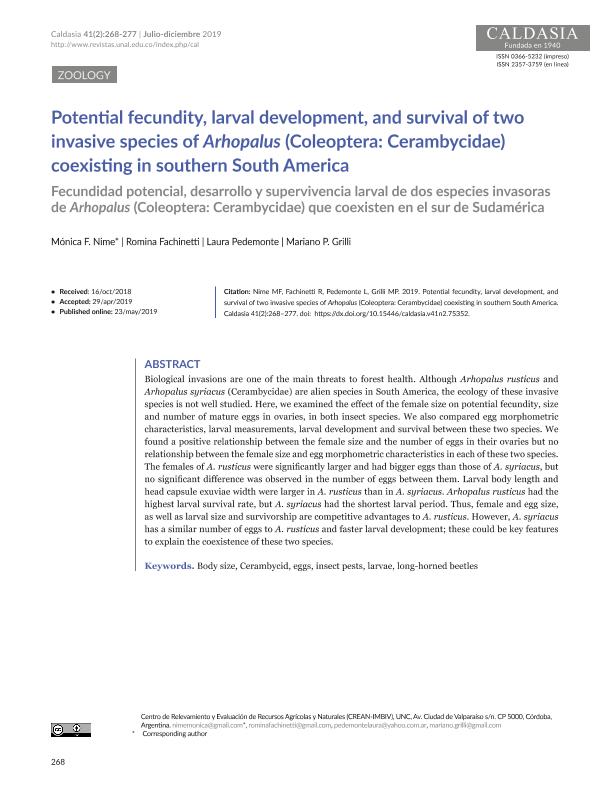Mostrar el registro sencillo del ítem
dc.contributor.author
Nime, Mónica Fernanda

dc.contributor.author
Fachinetti, Romina

dc.contributor.author
Pedemonte, María Laura

dc.contributor.author
Grilli, Mariano Pablo

dc.date.available
2020-10-19T15:53:56Z
dc.date.issued
2019-05
dc.identifier.citation
Nime, Mónica Fernanda; Fachinetti, Romina; Pedemonte, María Laura; Grilli, Mariano Pablo; Potential fecundity, larval development, and survival of two invasive species of Arhopalus (Coleoptera: Cerambycidae) coexisting in southern South America; Universidad Nacional de Colombia. Facultad de Ciencias.Instituto de Ciencias Naturales; Caldasia; 41; 2; 5-2019; 268-277
dc.identifier.issn
0366-5232
dc.identifier.uri
http://hdl.handle.net/11336/116123
dc.description.abstract
Biological invasions are one of the main threats to forest health. Although Arhopalus rusticus and Arhopalus syriacus (Cerambycidae) are alien species in South America, the ecology of these invasive species is not well studied. Here, we examined the effect of the female size on potential fecundity, size and number of mature eggs in ovaries, in both insect species. We also compared egg morphometric characteristics, larval measurements, larval development and survival between these two species. We found a positive relationship between the female size and the number of eggs in their ovaries but no relationship between the female size and egg morphometric characteristics in each of these two species. The females of A. rusticus were significantly larger and had bigger eggs than those of A. syriacus, but no significant difference was observed in the number of eggs between them. Larval body length and head capsule exuviae width were larger in A. rusticus than in A. syriacus. Arhopalus rusticus had the highest larval survival rate, but A. syriacus had the shortest larval period. Thus, female and egg size, as well as larval size and survivorship are competitive advantages to A. rusticus. However, A. syriacus has a similar number of eggs to A. rusticus and faster larval development; these could be key features to explain the coexistence of these two species.
dc.format
application/pdf
dc.language.iso
eng
dc.publisher
Universidad Nacional de Colombia. Facultad de Ciencias.Instituto de Ciencias Naturales

dc.rights
info:eu-repo/semantics/openAccess
dc.rights.uri
https://creativecommons.org/licenses/by-nc-sa/2.5/ar/
dc.subject
BODY SIZE
dc.subject
CERAMBYCID
dc.subject
EGGS
dc.subject
INSECT PESTS
dc.subject
LARVAE
dc.subject
LONG-HORNED BEETLES
dc.subject.classification
Zoología, Ornitología, Entomología, Etología

dc.subject.classification
Ciencias Biológicas

dc.subject.classification
CIENCIAS NATURALES Y EXACTAS

dc.title
Potential fecundity, larval development, and survival of two invasive species of Arhopalus (Coleoptera: Cerambycidae) coexisting in southern South America
dc.title
Fecundidad potencial, desarrollo y supervivencia larval de dos especies invasoras de arhopalus (Coleoptera: cerambycidae) que coexisten en el sur de Sudamérica
dc.type
info:eu-repo/semantics/article
dc.type
info:ar-repo/semantics/artículo
dc.type
info:eu-repo/semantics/publishedVersion
dc.date.updated
2020-09-21T14:47:40Z
dc.identifier.eissn
2357-3759
dc.journal.volume
41
dc.journal.number
2
dc.journal.pagination
268-277
dc.journal.pais
Colombia

dc.journal.ciudad
Bogota
dc.description.fil
Fil: Nime, Mónica Fernanda. Consejo Nacional de Investigaciones Científicas y Técnicas. Centro Científico Tecnológico Córdoba. Instituto Multidisciplinar de Biología Vegetal (P). Grupo Vinculado Centro de Relevamiento y Evaluación de Recursos Agrícolas y Naturales; Argentina
dc.description.fil
Fil: Fachinetti, Romina. Consejo Nacional de Investigaciones Científicas y Técnicas. Centro Científico Tecnológico Córdoba. Instituto Multidisciplinar de Biología Vegetal (P). Grupo Vinculado Centro de Relevamiento y Evaluación de Recursos Agrícolas y Naturales; Argentina
dc.description.fil
Fil: Pedemonte, María Laura. Consejo Nacional de Investigaciones Científicas y Técnicas. Centro Científico Tecnológico Córdoba. Instituto Multidisciplinar de Biología Vegetal (P). Grupo Vinculado Centro de Relevamiento y Evaluación de Recursos Agrícolas y Naturales; Argentina
dc.description.fil
Fil: Grilli, Mariano Pablo. Consejo Nacional de Investigaciones Científicas y Técnicas. Centro Científico Tecnológico Córdoba. Instituto Multidisciplinar de Biología Vegetal (P). Grupo Vinculado Centro de Relevamiento y Evaluación de Recursos Agrícolas y Naturales; Argentina
dc.journal.title
Caldasia

dc.relation.alternativeid
info:eu-repo/semantics/altIdentifier/doi/http://dx.doi.org/10.15446/caldasia.v41n2.75352
dc.relation.alternativeid
info:eu-repo/semantics/altIdentifier/url/https://revistas.unal.edu.co/index.php/cal/article/view/75352
Archivos asociados
